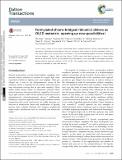Files in this item
Formylated chloro-bridged iridium(III) dimers as OLED materials : opening up new possibilities
Item metadata
| dc.contributor.author | Wong, Michael Y. | |
| dc.contributor.author | Xie, Guohua | |
| dc.contributor.author | Tourbillon, Clarisse | |
| dc.contributor.author | Sandroni, Martina | |
| dc.contributor.author | Cordes, David Bradford | |
| dc.contributor.author | Slawin, Alexandra Martha Zoya | |
| dc.contributor.author | Samuel, Ifor David William | |
| dc.contributor.author | Zysman-Colman, Eli | |
| dc.date.accessioned | 2015-05-12T08:31:04Z | |
| dc.date.available | 2015-05-12T08:31:04Z | |
| dc.date.issued | 2015-05-14 | |
| dc.identifier | 160126071 | |
| dc.identifier | cec0440e-72c5-4ea1-9247-a985700e4be4 | |
| dc.identifier | 84928795393 | |
| dc.identifier | 000353643300012 | |
| dc.identifier.citation | Wong , M Y , Xie , G , Tourbillon , C , Sandroni , M , Cordes , D B , Slawin , A M Z , Samuel , I D W & Zysman-Colman , E 2015 , ' Formylated chloro-bridged iridium(III) dimers as OLED materials : opening up new possibilities ' , Dalton Transactions , vol. 44 , no. 18 . https://doi.org/10.1039/C4DT03127J | en |
| dc.identifier.issn | 1477-9226 | |
| dc.identifier.other | ORCID: /0000-0002-5366-9168/work/28024001 | |
| dc.identifier.other | ORCID: /0000-0001-7183-6022/work/56639120 | |
| dc.identifier.other | ORCID: /0000-0002-9527-6418/work/56861931 | |
| dc.identifier.uri | https://hdl.handle.net/10023/6631 | |
| dc.description | Date of Acceptance: 17/10/2014 | en |
| dc.description.abstract | In this study, a series of four formyl-substituted chloro-bridged iridium(III) dimers were prepared. Their absorption, photophysical and electrochemical properties were studied in dichloromethane solution. It was found that as the formyl content increased on the cyclometalating ligands, emission unexpectedly became brighter. Organic light-emitting diodes (OLEDs) were fabricated using each of these iridium dimers as the emitter. The OLED fabricated using the brightest of the series, 2b, as the dopant afforded a decent external quantum efficiency (EQE) of 2.6%. This suggests that chloro-bridged iridium dimers are potential candidates as solid-state emitters. | |
| dc.format.extent | 3350381 | |
| dc.language.iso | eng | |
| dc.relation.ispartof | Dalton Transactions | en |
| dc.subject | QD Chemistry | en |
| dc.subject | DAS | en |
| dc.subject.lcc | QD | en |
| dc.title | Formylated chloro-bridged iridium(III) dimers as OLED materials : opening up new possibilities | en |
| dc.type | Journal article | en |
| dc.contributor.sponsor | EPSRC | en |
| dc.contributor.institution | University of St Andrews. School of Physics and Astronomy | en |
| dc.contributor.institution | University of St Andrews. School of Chemistry | en |
| dc.contributor.institution | University of St Andrews. EaSTCHEM | en |
| dc.contributor.institution | University of St Andrews. Condensed Matter Physics | en |
| dc.identifier.doi | https://doi.org/10.1039/C4DT03127J | |
| dc.description.status | Peer reviewed | en |
| dc.identifier.url | http://www.rsc.org/suppdata/dt/c4/c4dt03127j/c4dt03127j1.pdf | en |
| dc.identifier.grantnumber | EP/K039210/1 | en |
This item appears in the following Collection(s)
Items in the St Andrews Research Repository are protected by copyright, with all rights reserved, unless otherwise indicated.

